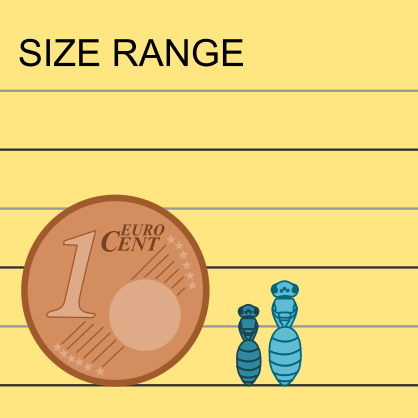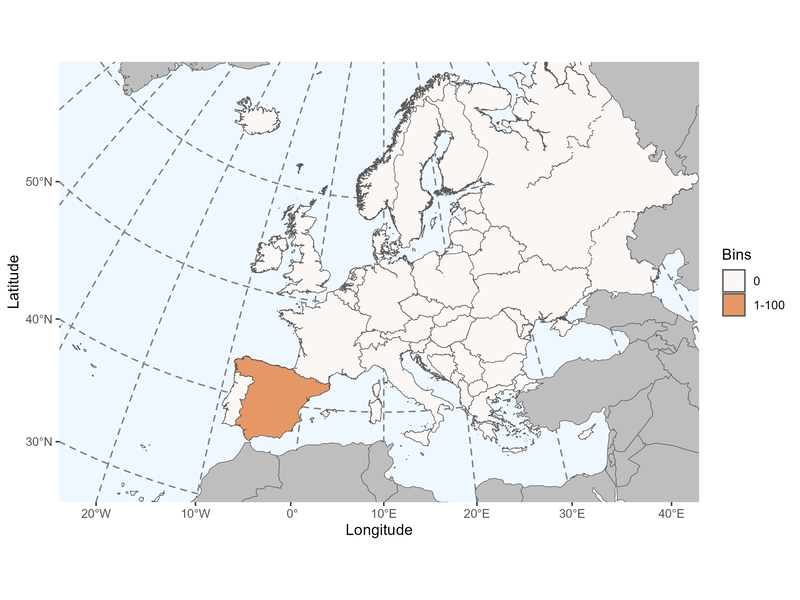Author: Warncke, 1972
|
Type species: Panurgus phyllopodus Warncke, 1972, by original designation.
|
Clade: Anthophila
Family: Andrenidae Subfamily: Panurginae Tribe: Panurgini |
|
Distinctive traits
|
Pictures of distinctive traits
(Sorry, there is no picture available at this time. If you have some and would like to become a contributor to IDmyBee, please contact us.) |
Morphologically close genera, and how to distinguish them:
Males of Flavipanurgus species have eyes ventrally diverging, so that they are closer from one another at the top.
Simpanurgus species have a glossa shorter than the prementum.
Panurgus has a brown/black cuticle on the head and / or metasoma.
Clavipanurgus & Panurginus species have submarginal cell 2 smaller than cell 1, recurrent vein 1 almost touching cubital transverse vein 1. Females have sparse and short hairs on posterior tibia and basitarsus.
Ammobates, Biastes, Parammobatodes & Pasites have a somewhat protruding clypeus and a long-tongue morphology (segments 1 and 2 of maxillary palpi are strongly elongated).
- Simpanurgus - Flavipanurgus (Spain only)
Males of Flavipanurgus species have eyes ventrally diverging, so that they are closer from one another at the top.
- Simpanurgus - Camptopoeum
Simpanurgus species have a glossa shorter than the prementum.
- Simpanurgus - Panurgus
Panurgus has a brown/black cuticle on the head and / or metasoma.
- Simpanurgus - Clavipanurgus & Panurginus
Clavipanurgus & Panurginus species have submarginal cell 2 smaller than cell 1, recurrent vein 1 almost touching cubital transverse vein 1. Females have sparse and short hairs on posterior tibia and basitarsus.
- Simpanurgus - Ammobates, Biastes, Parammobatodes & Pasites
Ammobates, Biastes, Parammobatodes & Pasites have a somewhat protruding clypeus and a long-tongue morphology (segments 1 and 2 of maxillary palpi are strongly elongated).
General comments on Simpanurgus species identification
There is only one species recorded in Europe.
There is only one species recorded in Europe.
Simpanurgus species found in Europe (Ghisbain et al. 2023):
Simpanurgus phyllopodus (Warncke, 1972)
Simpanurgus phyllopodus (Warncke, 1972)
Page contributors:
You noticed a mistake? You have a suggestion to improve this page?
Don't keep it to yourself, contact us and become a contributor to IDmyBee!
References used to write this page:
- Adrien Perrard (Dec. 2023)
- Adrien Perrard (Dec. 2019)
You noticed a mistake? You have a suggestion to improve this page?
Don't keep it to yourself, contact us and become a contributor to IDmyBee!
References used to write this page:
- Ghisbain, G., Rosa, P., Bogusch, P., Flaminio, S., Le Divelec, R., Dorchin, A., Kasparek, M., Kuhlmann, M., Litman, J., Mignot, M., Müller, A., Praz, C., Radchenko, V.G., Rasmont, P., Risch, S., Roberts, S.P.M., Smit, J., Wood, T.J., Michez, D. & Reverte, S. (2023). The new annotated checklist of the wild bees of Europe (Hymenoptera: Anthophila). Zootaxa, 5327(1), 1-147.
- Michener, C.D. 2007. The Bees of the World, 2nd Edition. The John Hopkins University Press, Baltimore.
- Michez D., Rasmont P., Terzo, M., Vereecken, N. 2019. Abeilles d'Europes. Hymenoptères d'Europes, Volume 1. N.A.P. Editions.
- Nieto, A., Roberts, S. P., Kemp, J., Rasmont, P., Kuhlmann, M., García Criado, M., ... & Michez, D. 2014. European red list of bees. Luxembourg: Publication Office of the European Union, 98. (IUCN 2014)
- Rasmont, P., Devalez, Jelle, Pauly, A., Michez, D. & Radchenko, V.G. 2017. Addition to the checklist of IUCN European wild bees (Hymenoptera: Apoidea). Annales de la Société entomologique de France 53: 17-32.


